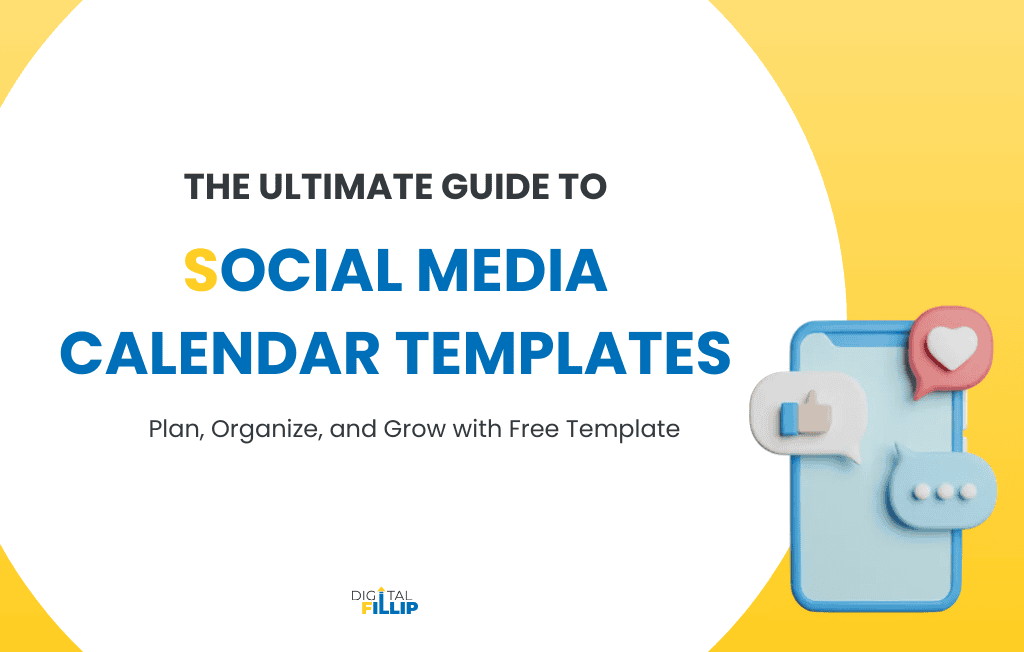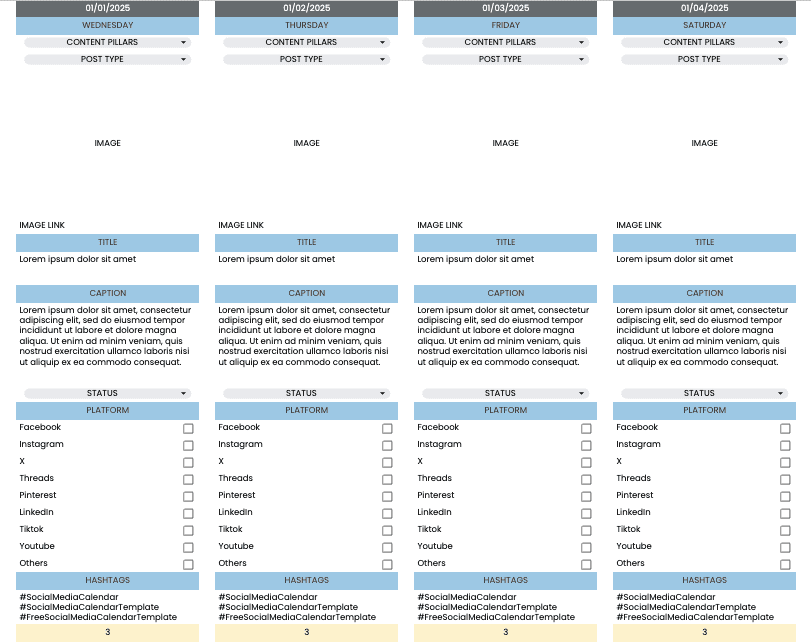The Ultimate Guide to Social Media Calendar Templates: Plan, Organize, and Grow with Free Template
Digital Fillip
Digital Marketing Agency
- Phone:0956-6689-157
- Email:inquiries@digitalfillip.com.com
Maintaining a strong social media presence is essential. As a business owner or marketer, having a well-planned content strategy helps amplify your brand’s voice and fosters meaningful engagement.
What is a Social Media Calendar Template?
A social media calendar template is a structured framework that helps your business plan, organize, and schedule their content across various platforms. It serves as a roadmap for content creation, ensuring consistency and strategic alignment with your business goals.
Why a Social Media Calendar is Essential
A structured social media calendar serves as the backbone of any digital strategy. It enables businesses to:
- Maintain Consistency: Regular posting keeps the audience engaged and reinforces brand recognition.
- Strategically Plan Content: Align posts with marketing goals, product launches, and seasonal trends.
- Optimize Cross-Platform Efforts: Tailor content to suit each platform’s unique audience and format.
- Enhance Team Collaboration: Streamline workflows and ensure all stakeholders are aligned.
Crafting an Effective Social Media Calendar
To build an efficient calendar that aligns with your business objectives and audience engagement goals, follow these essential steps:
1. Audit your Current Social Media Presence
- Identify which platforms resonate most with your target audience.
- Analyze past performance to determine the most effective content types and posting times.
2. Define a Balanced Content Mix
- Educational Content: Sharing insights and tips relevant to your industry.
- Promotional Content: Highlighting your products, services, and special offers.
- Engagement Content: Encouraging interaction through polls, questions, and user-generated content.
- Curated Content: Sharing valuable insights from industry leaders to position your brand as a thought leader.
3. Establish a Posting Schedule
- Determine optimal posting frequencies for each platform.
- Schedule posts at times when your audience is most active.
4. Utilize a Centralized Tool
- Implementing a content management system or a simple spreadsheet helps you plan and track posts.
- Ensure your team has access to maintain transparency and collaboration.
Parts of a Social Media Content Calendar Template
A well-structured social media content calendar typically includes:
- Content Type: Identifies whether the post is educational, promotional, or engagement-driven.
- Platform: Specifies where the content will be published (e.g., Facebook, Instagram, LinkedIn).
- Date: Details when the post will go live.
- Post Copy: Contains the text or caption for the post.
- Media Assets: Includes images, videos, or links to be used.
How to Use a Social Media Calendar Template
- Plan Content in Advance: Allocate topics, themes, and campaign schedules ahead of time.
- Assign Responsibilities: Designate team members for content creation, review, and publishing.
- Optimize and Test: Using analytics, determine what works best and refine your strategy accordingly.
- Stay Flexible: Allowing room for real-time content adjustments based on trends or audience feedback is key.
Social Media Calendar Template
To simplify social media planning, use a comprehensive, customizable social media calendar template. This tool helps you plan, execute, and monitor your social media strategy effectively.
Frequently Asked Questions
The ideal posting frequency depends on the platform. For example, Facebook and Instagram perform well with 3-5 posts per week, while X and LinkedIn benefit from daily updates.
Planning at least a month in advance ensures consistency while allowing flexibility for trending topics and real-time engagement.
While repurposing content is beneficial, it’s best to tailor each post to the platform’s audience and format for maximum engagement.
Peak times vary by platform and audience, but mid-mornings and early evenings tend to perform well. Using analytics tools helps refine my posting schedule.
Tracking key metrics such as engagement rates, click-through rates, follower growth, and conversions provides insights for strategy adjustments.
Key Takeaways
- A structured social media calendar ensures consistency, strategic planning, and better engagement.
- Diversifying content types—educational, promotional, engagement, and curated—keeps my audience interested.
- Scheduling posts at optimal times enhances reach and impact.
- Using a centralized tool improves efficiency and collaboration.
- Tracking performance metrics helps refine strategies for better results.
Maximize Social Media Impact
A strategic social media approach can significantly enhance brand visibility and audience engagement. By leveraging a well-structured social media calendar, you can create impactful content, build stronger connections, and drive measurable results.
Contact Digital Fillip for Expert Social Media Strategies
Taking control of your social media presence with a well-planned calendar and a data-driven strategy makes all the difference.
Table of Contents
- Introduction
- What is a Social Media Calendar Template?
- Why a Social Media Calendar is Essential
- Crafting an Effective Social Media Calendar
- Parts of a Social Media Content Calendar Template
- How to Use a Social Media Calendar Template
- Social Media Calendar Template
- Frequently Asked Questions
- Key Takeaways
- Maximize Social Media Impact
Copyright © 2022 Digital Fillip



